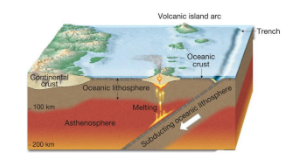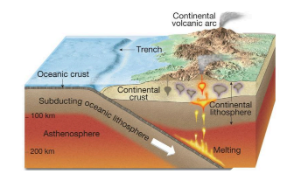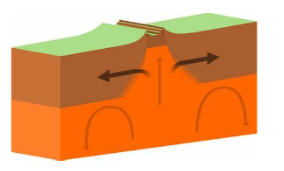Earth Science CET (Plate Boundaries and Geological Time Scales, and Rocks)
1/58
There's no tags or description
Looks like no tags are added yet.
Name | Mastery | Learn | Test | Matching | Spaced |
|---|
No study sessions yet.
59 Terms
They interact at locations called plate boundaries,
found at the edge of the lithospheric plates.
Tectonic plates
This is a type of boundary where two
plates meet and push one another.
Convergent boundary
When the crust is destroyed, the denser plate sinks in a
process called?
Subduction
It is is a process of pulling something down.
Subduction
Types of Convergent Boundaries:
Continental-continental convergent boundaries
Oceanic-continental convergent boundaries
Oceanic-oceanic convergent boundaries
It is a geologic process that occurs at mid-
ocean ridges, where new oceanic crust is formed through
volcanic activity and then gradually moves away from the ridge.
Seafloor spreading

One oceanic plate subducts another oceanic plate.
Forms mountains, earthquakes, volcanic islands and
trenches when plates collide.
Oceanic-Oceanic Convergent Boundaries

When one plate is oceanic and the other is continental,
the denser oceanic plate is subducted, forming an
orogenic belt and associated mountain range.
Volcanic arc is a chain of volcanoes formed above a
subducting plate.
Oceanic-Continental Convergent Boundaries
It is when a subduction zone is
destroyed, mountains produced, and two continents
sutured together.
Continental-Continental Convergent Boundaries
Continental collision
Examples of Convergent Boundaries:
Mount Fuji, Japan
Mount Lassen, California
Himalayan Mountains
Andes, South America
Regions where a plate moves away from each
other/comes apart.
Most are found deep in the ocean
floor, hence separation of plate is also called “sea floor
spreading.”
Rift valleys and ocean ridges form at these boundaries.
Divergent boundaries
Oceanic plates are composed of mafic or basaltic rock.
When oceanic plates separate, brand new crust is created.
This crust can remain underwater creating ridges, or can
rise to the surface creating islands.
Oceanic Plate Divergent Boundary
This is an underwater mountain system formed by plate
tectonics.
Mid-Ocean Ridge
When continental plates separate, volcanoes could form to
create new crust.
Continental Plate Divergent Boundary
A linear-shaped lowland between several highlands
created by the action of a geologic rift or fault.
Rift Valley
Examples of Divergent Boundaries:
East Asian Rift
Mid-Atlantic Ocean Ridge

Places where plates slide sideways past each other.
The fracture zone that forms a transform boundary is known
as a transform fault.
Transform Boundaries
Examples of Transform Boundaries:
Calexico, California
San Andreas Fault

Types of Eon:
Hadean Eon (4.6 to 4 billion years ago)
Archean Eon (4 to 2.5 billion years ago)
Proterozoic Eon (2.5 billion to 541 million years ago)
Phanerozoic Eon (541 million years ago to present)
The Earth forms from the solar nebula.
The Moon is believed to have formed as a result of a
collision between the early Earth and a Mars-sized body,
named Theia.
Hadean Eon (4.6 to 4 billion years ago)
The earliest known life forms, simple single-celled organisms
(prokaryotes), appear.
The Earth's crust cools enough to form continents.
Archean Eon (4 to 2.5 billion years ago)
Cyanobacteria produce oxygen through photosynthesis,
leading to the Great Oxidation Event.
Complex cells with a nucleus (eukaryotes) appear.
Severe glaciations occur, potentially covering the Earth in
ice.
Proterozoic Eon (2.5 billion to 541 million years ago)
Rapid diversification of life forms, including many major
groups of animals.
Plants colonize land, leading to significant changes in Earth's
atmosphere and ecosystems.
Phanerozoic Eon (541 million years ago to present)
This is a term that refers to the rapid
emergence of complex life forms in the Cambrian Period,
about 541 million years ago. It was characterized by the
appearance of many of the major animal phyla that make up
modern animal life.
Cambrian explosion
Eras within the Phanerozoic Eon:
Paleozoic Era (541 to 252 million years ago)
Mesozoic Era (252 to 66 million years ago)
Cenozoic Era (66 million years ago to present)
The Cambrian Explosion, a major
diversification of life, occurs.
Cambrian Period
Marine life flourishes, and the first
vertebrates appear.
Ordovician Period
The first vascular plants appear on land.
Silurian Period
Known as the "Age of Fishes," the first
amphibians appear.
Devonian Period
Extensive forests of vascular plants
form, leading to large coal deposits; first reptiles appear.
Carboniferous Period
Ends with the largest mass extinction in
Earth's history, the Permian-Triassic extinction event.
Permian Period
Dinosaurs and mammals first appear.
Triassic Period
Dinosaurs dominate the land; the first birds
appear.
Jurassic Period
Flowering plants appear; ends with the
Cretaceous-Paleogene extinction event, which wipes out the
non-avian dinosaurs.
Cretaceous Period
Mammals diversify and become the
dominant land animals.
Paleogene Period
Further diversification of mammals and
birds; hominins (early human ancestors) appear.
Neogene Period
Includes the Pleistocene and Holocene
epochs; characterized by repeated glacial cycles; modern
humans (Homo sapiens) appear and develop civilization.
Quaternary Period
It was a supercontinent that existed during the late
Paleozoic and early Mesozoic eras. It assembled from
earlier continental units approximately 335 million years
ago and began to break apart about 175 million years ago.
Pangaea
Pangaea formed through the _________ of
smaller landmasses and continents over millions of years.
This process began in the late Carboniferous period
(around 335 million years ago) and continued into the
early Permian period.
Collision and amalgamation
Pangaea was surrounded by a vast global ocean called
________ and included a smaller inland sea known as
_____.
Panthalassa
Tethys
The breakup of Pangaea began in the early Jurassic period
(about 175 million years ago) due to?
Rifting and the
movement of tectonic plates.
Pangaea initially split into two smaller supercontinents:
Laurasia in the northern hemisphere
Gondwana in the southern hemisphere
Over millions of years, Laurasia and Gondwana continued
to break apart into the continents we recognize today, which are:
Laurasia:
North America, Europe, and Asia
Gonwana:
South America, Africa, Antartica, India, and Australia
Types of Rocks:
Igneous Rocks
Sedimentary Rocks
Formed from the cooling and solidification of molten rock
(magma or lava).
Igneous Rocks
Igneous Rocks can range from?
Coarse-grained (intrusive) to Fine-grained (extrusive)
Igneous Rocks are typically composed of minerals such as:
Quartz
Feldspar
Mica
Olivine
Fluorite is much less common to find in igneous rocks.
The higher the silica, the ______ is the rock, while the
faster the rate of ______, the finer the crystals.
Lighter
Crystallization
Formed from magma that
cools slowly beneath the Earth's surface. Examples include
granite, diorite, and gabbro;
Intrusive (Plutonic):
Formed
from lava that cools quickly on the Earth's surface.
Examples include basalt, obsidian, rhyolite, and andesite.
Extrusive (Volcanic):
Formed from the accumulation and compaction of
sediments or by the precipitation of minerals from water.
Often show distinct layers or strata.
May contain fossils, which are remains of ancient
organisms
Sedimentary Rocks
Types of Sedimentary Rocks:
Clastic
Chemical
Organic
Formed from fragments of other rocks that
have been weathered, transported, and deposited.
Example: Sandstone.
Clastic
Formed from the precipitation of minerals
from water. Example: Limestone.
Chemical
Formed from the accumulation of plant or
animal debris. Example: Coal.
Organic
Formed from the alteration of existing rock types (igneous,
sedimentary, or other metamorphic rocks) through heat,
pressure, and/or chemically active fluids.
Can range from fine-grained to coarse-grained.
New minerals may form under high pressure and
temperature conditions.
Metamorphic Rocks
Types of Metamorphic Rocks
Foliated
Non-foliated
Have a layered or banded appearance due to
the alignment of minerals. Example: Schist.
Foliated
Do not have a layered appearance.
Example: Marble
Non-foliated